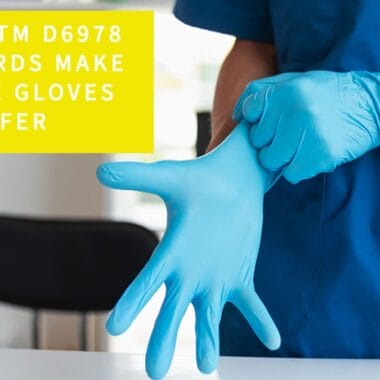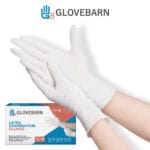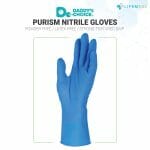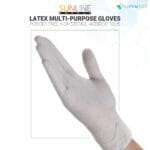Wearing gloves in the kitchen can help maintain hygiene and food safety when cooking, cleaning, and entertaining guests. Nitrile gloves are the best type of kitchen gloves that are durable, allergen-friendly, and food-safe.
The Versatility of Food-Safe Nitrile Gloves for Kitchen Use
Using gloves in the kitchen, specifically nitrile, provides a barrier of protection between your hands and the food, helping to reduce the risk of cross-contamination. This is especially significant for preventing the spread of bacteria and other germs to maintain high food safety standards in the kitchen.
Nitrile, made of synthetic rubber, is more durable and puncture-resistant than latex or vinyl gloves. It’s essential to use tear-resistant gloves when handling kitchen tools and equipment without the risk of tearing or puncturing the glove. Latex-free gloves, like nitrile, are an excellent choice for those with latex allergies. They also resist oils and certain chemicals, making them suitable gloves for cleaning tasks.
Textured nitrile gloves provide a better grip when handling wet or slippery items, helping prevent spills or accidents in the kitchen. Bulk nitrile gloves are suitable for a wide range of kitchen tasks. Whether preparing or serving food, washing dishes, or cleaning up, they are versatile PPE tools in the kitchen. Nitrile gloves are known for their comfortable fit, conforming to the shape of the hand. This can be important in a kitchen where tasks require precision and skill.
While being durable, they are also disposable gloves, which are essential for maintaining high hygiene standards in the kitchen. In addition to nitrile gloves’ many benefits, they are also a cost-effective pair of gloves, making them a practical choice for kitchen environments requiring frequent glove changes.
7 Best Uses for Nitrile Gloves in the Kitchen
Nitrile gloves are incredibly versatile kitchen gloves for cooking, serving, and cleaning. There are many advantages to wearing nitrile gloves for cooking or baking from home, for professional chefs, and the food service industry. Nitrile offers many benefits for various applications, especially in the kitchen. Let’s look at why nitrile gloves are an indispensable tool in your kitchen:
1. Handling Raw Meat and Seafood
Wearing nitrile gloves when handling raw meat or seafood in the kitchen is essential to prevent the spreading of any bacteria or contaminants. Gloves provide a barrier between your skin and the raw meats, preventing bacteria from touching your hands or getting under your nails. This can be especially useful when preparing a meal or hosting guests, ensuring peace of mind and preventing cross-contamination for a clean and hygienic kitchen.
2. Chopping Spicy or Pungent Ingredients
Putting on gloves while chopping ingredients can protect your skin from irritation and prevent strong odors from lingering on your hands. Especially when cutting onions or chili peppers, wearing disposable nitrile gloves can allow you to remove your gloves before touching your eyes or a separate ingredient.
3. Preparing Food for Those with Allergies
Stocking your kitchen with latex-free nitrile gloves can be especially beneficial when serving guests or family members with latex allergies. Additionally, these durable gloves can prevent cross-contamination when preparing meals for those with food allergies, especially in kitchens with multiple dishes and types of food.
4. Mixing and Kneading Dough
Wearing gloves when handling dough can keep your hands clean and prevent the dough from sticking to your hands. Nitrile gloves in the kitchen make the kneading and mixing dough more hygienic and efficient. Wearing kitchen gloves like nitrile makes the clean-up process quicker and less messy.
5. Handling Colorful or Sticky Foods
When working with foods that stain, such as beets or turmeric, nitrile gloves can protect your hands from discoloration or remaining stains. Also, when cooking or baking with food coloring, wearing gloves can protect the skin from artificial dyes staining it. Handling sticky or gooey foods in the kitchen can significantly slow the process without gloves, requiring recurring hand-washing. Disposable gloves like nitrile designed for frequent glove changes make cooking and baking incredibly convenient and mess-free.
6. Cleaning and Sanitizing Tasks
One of the most beneficial uses of nitrile gloves in the kitchen is for cleaning and sanitizing tasks. Chemical-resistant gloves, like nitrile, are ideal for handling cleaning products while washing dishes or sanitizing kitchen surfaces. Harsh cleaning agents can damage the skin, causing irritation, burning, or drying out the skin. Wearing nitrile gloves while cleaning the kitchen can prevent cross-contamination and ensure a clean environment while protecting your skin.
7. Plating and Serving Food
When serving family members or hosting a dinner party, nitrile gloves help provide a clean, hygienic way to plate and serve food. Cleanliness is essential in professional and personal kitchen settings where presentation and safety are critical.
Buying Bulk Nitrile Gloves for Your Home
Nitrile gloves are a valuable asset in the kitchen, aiding in tasks that require hygiene, protection from irritants, or precision. They help homeowners and chefs maintain cleanliness and prevent cross-contamination when cooking, baking, serving, and cleaning. There are several uses for nitrile gloves in the home, whether sanitizing bathrooms, handling raw meats or sticky foods in the kitchen, or cleaning up after children and pets.
Ensuring your home is stocked with a reliable and durable pair of personal protective equipment (PPE) gloves like nitrile is a practical decision for families and singles alike. Wearing nitrile gloves for several tasks around your home guarantees you can clean unsanitary surfaces and areas without the bacteria getting on your hands. FDA-approved nitrile gloves are an indispensable PPE tool for your kitchen and your living space as a whole. Purchasing nitrile gloves in bulk can ensure your inventory remains stocked for convenience and emergency needs.
Reference:
- Hygiene Food Safety. Should You Use Gloves in the Kitchen?


















